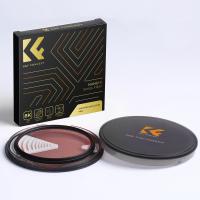Can I See Atoms With A Microscope?
No, atoms cannot be seen with a traditional optical microscope as they are much smaller than the wavelength of visible light. However, they can be indirectly observed and studied using techniques such as scanning tunneling microscopy and atomic force microscopy. These techniques use a probe to interact with the atoms and create an image based on the resulting data.
1、 Limitations of Microscopes

Microscopes have been an essential tool in scientific research for centuries, allowing us to observe and study the microscopic world. However, there are limitations to what microscopes can do, and one of the most significant limitations is the ability to see atoms.
Atoms are incredibly small, with a diameter of around 0.1 nanometers. This is far smaller than the resolution of even the most powerful optical microscopes, which can only resolve objects down to around 200 nanometers. This means that atoms are simply too small to be seen with a traditional microscope.
However, there are other types of microscopes that can be used to observe atoms. Scanning tunneling microscopes and atomic force microscopes use a probe to scan the surface of a sample, allowing individual atoms to be observed and manipulated. These microscopes have revolutionized our understanding of the atomic world, allowing us to study the properties and behavior of individual atoms and molecules.
Despite these advances, there are still limitations to what we can observe with microscopes. For example, the act of observing an atom can change its behavior, making it difficult to study certain phenomena. Additionally, there are still many unanswered questions about the behavior of atoms and molecules, and new technologies and techniques will be needed to continue pushing the boundaries of our understanding.
2、 Electron Microscopy

No, atoms cannot be seen with a traditional light microscope as they are much too small. The wavelength of visible light is much larger than the size of an atom, making it impossible to resolve individual atoms with a light microscope. However, with the development of electron microscopy, it is now possible to see individual atoms.
Electron microscopy uses a beam of electrons instead of light to image samples. The wavelength of electrons is much smaller than that of visible light, allowing for much higher resolution imaging. In fact, with modern electron microscopes, it is possible to see individual atoms and even the arrangement of atoms within a molecule.
However, it is important to note that electron microscopy has its limitations. The sample must be prepared in a specific way, and the imaging process can be time-consuming and technically challenging. Additionally, the electrons used in the imaging process can damage the sample, making it difficult to study biological samples or other delicate materials.
In summary, while traditional light microscopes cannot see individual atoms, electron microscopy has made it possible to visualize atoms and molecules at the atomic scale. However, electron microscopy is not without its limitations and challenges.
3、 Scanning Tunneling Microscopy

No, traditional optical microscopes cannot see atoms as they are limited by the wavelength of visible light. However, a technique called Scanning Tunneling Microscopy (STM) has been developed that allows us to see individual atoms. STM works by scanning a sharp metal tip over a surface and measuring the flow of electrons between the tip and the surface. This allows the tip to "feel" the atoms on the surface and create a 3D image of their positions.
STM has revolutionized our understanding of the atomic world and has allowed us to study the properties of materials at the atomic scale. It has also led to the development of new technologies such as nanotechnology and quantum computing.
The latest point of view on STM is that it continues to be a valuable tool for researchers in various fields. In recent years, advancements in STM technology have allowed for even higher resolution imaging and the ability to manipulate individual atoms. This has opened up new possibilities for studying the behavior of atoms and molecules in real-time, as well as for designing new materials with specific properties.
Overall, while traditional optical microscopes cannot see atoms, STM has provided us with a powerful tool for exploring the atomic world and has led to many exciting discoveries and advancements in science and technology.
4、 Atomic Force Microscopy

No, traditional optical microscopes cannot see atoms as they are much smaller than the wavelength of visible light. However, Atomic Force Microscopy (AFM) is a type of scanning probe microscopy that can visualize atoms and molecules at the nanoscale level. AFM works by scanning a sharp tip over the surface of a sample, and the interaction between the tip and the sample generates a 3D image of the surface topography.
AFM has revolutionized the field of nanotechnology and has enabled scientists to study the properties of materials at the atomic level. It has also been used to study biological molecules such as proteins and DNA. In recent years, AFM has been combined with other techniques such as infrared spectroscopy and Raman spectroscopy to provide even more detailed information about the chemical and physical properties of materials.
However, it is important to note that AFM has its limitations. It can only image the surface of a sample and cannot provide information about the internal structure of materials. Additionally, AFM requires a high level of expertise to operate and can be time-consuming to use. Nonetheless, AFM remains a powerful tool for studying the nanoscale world and has contributed significantly to our understanding of materials science and biology.







































